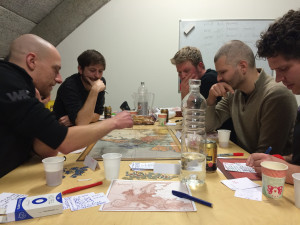In my post, It’s Not Failing. It’s Discovery I said, “Many entrepreneurs are high achievers and really hate failure – that is why they keep going. They’ll keep working and trying …” I think this statement deserves some discussion. Why are entrepreneurs more given to keep working through problems? What makes them better suited them some to launch new ideas?
This got me thinking about grit.
Perhaps you have seen Angela Lee Duckworth’s TEDx Talk. It has over 8M views and suggest you have a look.
You can call it:
- Stick-to- it-ness
- Tenacity
- Determination
- Not giving up …
Regardless of the name – Grit it is an attribute you must have to be an entrepreneur. Actually, it’s useful in about any aspect of life. I believe in it.
Wondering what your level of grit is? Take this U Penn test.
My interest isn’t how much grit you currently possess. A better question is, Can you become more gritty? (Clearly some people have more of it naturally.) I do believe that you can develop your grit and I’m profoundly interested in learning techniques to develop more of it.
From my experience here are three steps you can take to build your grit:
- Surround yourself with tenacious people. I don’t care if you are six or 60, peer pressure can be wonderful if you have the right peers. Gritty people can encourage you. They provide moral support when hard times come. I remember as a high schooler my father, brothers and I build a house in the Adirondacks. My father and brothers are accountants, not builders. I at 16 had the most skill just having made a book shelf in shop class. Later at a family dinner in this beautiful house we all build, I told the story of when my brothers and I seeing the pile of wood and cement blocks stacked up as far as the eye could see, said, “The old man really &^%$* up this time.” My father’s response, “I never thought we would fail. Thought it might take longer, cost more, but the house would get built”. That mental model – It may be a lot more difficult but you will ultimately prevail – is vital to increasing your grit. Not bad for a bunch of gritty accountants.
- Be flexible and creative on how you get to the goal. Of course, I assume you have clear goals, but the path there is not linear. Flexibility allows you to change your mind and continue to learn. This helps you find innovative solutions to what seem like hard or impossible problems. I thought this blog had some great ideas on how to do this.
- Keep very active to maintain high energy. I am not saying you need to run marathons. But gritty people are not couch potatoes. Grittiness takes energy. You need to have the physical stamina to work at a task for extended periods of time. That takes energy, both physical and mental, and lots of it. Keeping the right attitude helps you maintain that kind of energy level. Make a point to do things you are passionate about to keep your head right. More on that here.
Let’s review:
Surround yourself with moral and emotional support to:
- Externalize your commitments to other
- Focus your will
- Apply healthy peer pressure
Be flexible and assume there are:
- Multiple routes to the goal
- Problems that will require creativity
- Opportunities to experiment and discover
Fitness – Think mental, spiritual AND physical because grit takes:
- Lots of energy
- Endurance
- Stress reductions
Lastly, a word on perspective. A point Alfie Kohn, makes in his critique of grit is worth keeping in mind. He says gritty people sometimes exhibit “nonproductive persistence” and there are occasions when it doesn’t make “sense to persist with a problem that resists solution”. Make sure you are making real progress.
Assessing your tendency for “nonproductivity” can be difficult. I talk more about how to surround yourself with people who can give you perspective on the problem you’re trying to solve in my previous post, Four Tests to Vet Potential Business Advisors. A good advisor can help you determine when to quit and when to push ahead. The best business advisors and mentors are the ones who’ve succeeded (and failed) at solving their own business problems, making them just the right amount of gritty to be your guide.
What about you? Do you have a story of grit in the making? Tell me what about the person you know who exhibits grit.
Photo by DVIDSHUB
 The Early Thinking
The Early Thinking







